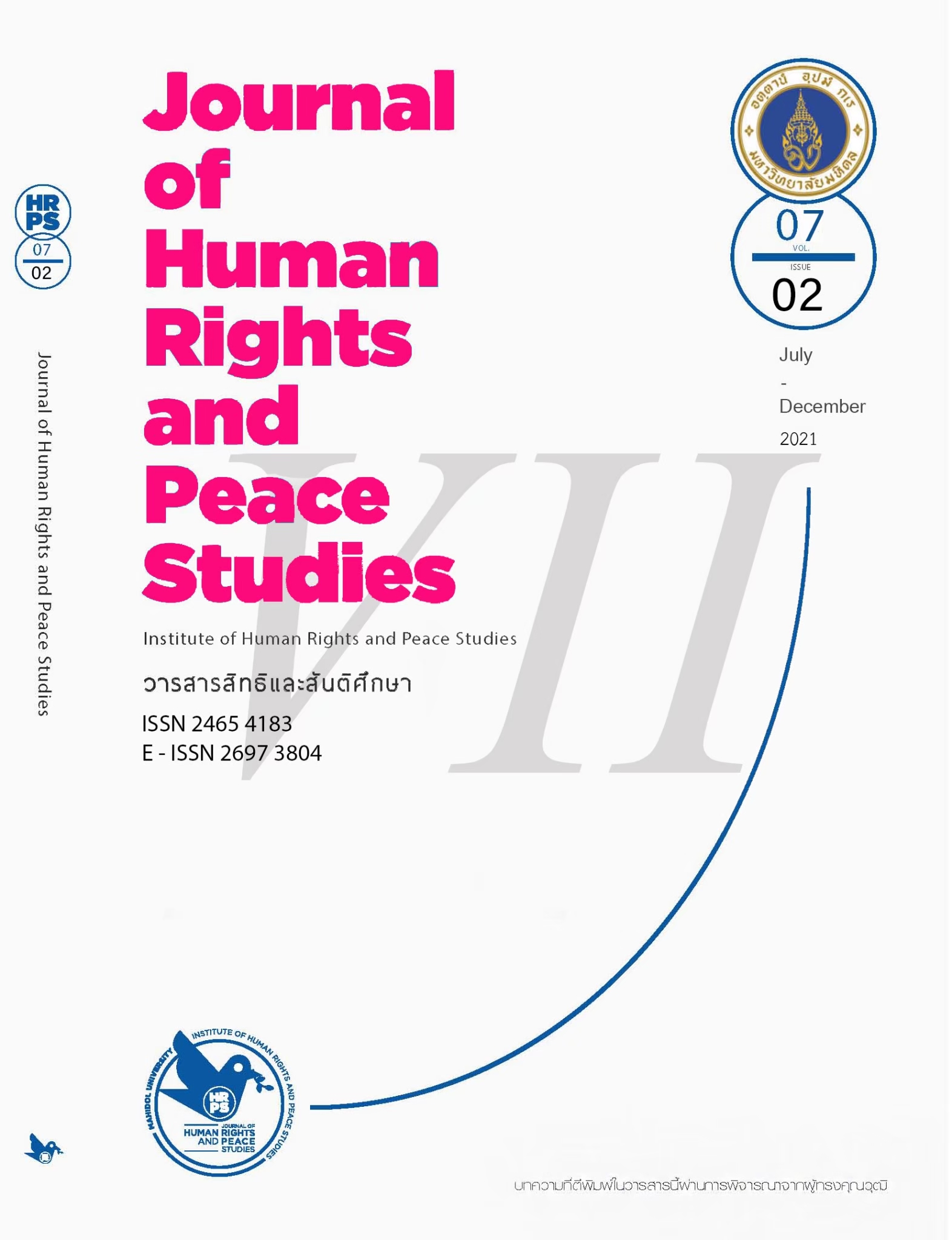Online Waisak: Celebrating Discrimination of Indonesian Buddhists
Main Article Content
Abstract
This paper scrutinizes the Waisak celebrations in Indonesia. Ethnographic methodology was conducted by participating the national ritual in 2016 and observing the online live-streaming ceremonies arranged by various Buddhist groups in 2020. It sought to answer (1) how Indonesian government supports and oppresses religions, schools of Buddhism in particular, and (2) when the celebration had been moved to online platform, how the relationship between the state and religion go on. It found that (1) though the discourse of national unity becomes the theme of Waisak festival every year, the celebration does not reflect the unity of different Buddhist organizations as previously claimed. In contrast, the state’s partiality has been marginalizing some Buddhist groups. (2) When the celebration had been moved to online platforms due to the Covid-19 pandemic, the state-supported ritual was canceled, which unintentionally allowed all Buddhist organizations to equally celebrate the Waisak in their personal ways. Religious discrimination was therefore increasing blurred, however, it still exists because religious groups are not free from the state’s gaze, and they seem to perform rituals to satisfy the state policy. Thus, the online space is not separated from the offline world, they are the continuity of spaces used in different times.
Article Details

This work is licensed under a Creative Commons Attribution-NonCommercial-NoDerivatives 4.0 International License.
The views, opinions, and pictures expressed in this journal are those of the authors and do not necessarily reflect the opinions and viewpoints of the editor and the editorial board. All rights are reserved by the authors and the Institute of Human Rights and Peace Studies of Mahidol University. No part of this journal may be reproduced, stored in a retrieval system, or transmitted in any form or by any means without the prior permission in writing from the journal’s editor, or as expressly permitted by law, or under terms agreed with the appropriate reprographics rights organization. Non-commercial use of information in this journal must be properly referenced.
References
Abalahin, A. J. (2018). A sixth religion?: Confucianism and the negotiation of Indonesian-Chinese identity under the Pancasila state. In A. C.Willford, & K. M. George (Eds.), Spirited politics: Religion and public life in contemporary Southeast Asia(pp. 119-142). Cornell University Press.
Bagir, Z. A.,Asfinawati, Suhadi, & Arianingtyas, R. (2020). Limitations to freedom of religion or belief in Indonesia: Norms and practices. Religion and Human Rights, 15(1-2), 39-56.https://doi.org/10.1163/18710328-BJA10003
Bhante Kamsai. (2020). Home[Facebook page]. Facebook. Retrieved May 31, 2020from https://www.facebook.com/BKamsai/
Brown, I. (2004). The revival of Buddhism in modern Indonesia. In M. Ramsted (Ed.), Hinduism in modern Indonesia: A minority religion between local, national and global interests (pp. 45-55). Routledge Curzon.
Buddhayana TV. (2020, May 7). Waisak national KBI 2564BE[National Waisak of Indonesian Buddhayana Family][Video]. YouTube.https://www.youtube.com/watch?v=GmW54OVg6Qc.
Christian Solidarity Worldwide. (2014, May 28). Mosques and churches closed in Indonesia. Retrieved August 5, 2020from http://www.csw.org.uk/2014/5/28/news/2119/article.htm
Damanik, C. (Ed.). (2018, August 21). Kronologi kasus Meiliana yang dipenjara karena keluhkan pengeras suara azan[Chronology of the case of Ibu Meiliana who jailed due to critique of praying’s sound]. Kompas. Retrieved August 6, 2020from https://bit.ly/3iuTUob.
Dawson, L. L., & Cowan, D. E. (Eds.). (2004). Religion online: Finding faith on the Internet. Routledge.
Dawson, L. L., & Hennebry, J. (2004). New religions and the internet: Recruiting in a new public space. Routledge.
Dhammahuto, H. (2013). The Buddhist monks’ roles in propagating Buddhism in Indonesia. [Master’s thesis, Mahachulalongkornrajavidyalaya University].
Diputhera, O. (2010). Agama Buddha berkembang di Indonesia[The development of Buddhism in Indonesia]. Okaberseri Arya Suryacandra.
DPP Walubi. (2020, May 7). Perayaan Tri Suci Waisak 2564BE/2020[Waisak Celebration 2564/2020][Video]. YouTube.https://www.youtube.com/watch?v=gbmCIdjzK5g.
Durkheim, E. (2002). Suicide: A study in sociology(J. Spauding, & G. Simpson, G., Trans.). Routledge.
Epafras, L. C., Kaunang, H. P., & Asri, S. (2019). Religious blasphemy and monitory society in Indonesian digital age. Jurnal Kawistara, 9(2), 220-230.https://doi.org/10.22146/kawistara.41169f
Fauzia, M. (2019, August 16). Ini 10kementerian/lembaga dengan anggaran terbesar[These are 10Ministries/Institutions with the largest budget]. Kompas. Retrieved May 29, 2020from https://bit.ly/2Dlrjmk.
Hobsbawm, E., & Ranger, T. (Eds.). (2012). The invention of tradition. Cambridge University Press.
Juangari, E.(2016). Menaburbenih dharma di nusantara: Riwayat singkat Y.A. MNS Ashin Jinarakkhita[Sow the seed of dharma in the nation: A short biography of Ven. Ashin Jinarakkhita]. Karaniya.
Lövheim, M., & Campbell, H. A. (2017). Considering critical methods and theoretical lenses in digital religion studies. New Media & Society,19(1),5-14.https://doi.org/10.1177/1461444816649911
MacWilliams, M. W. (2004). Virtual pilgrimage to Ireland’s Croagh Patrick. In L. L. Dawson & D. E. Cowan (Eds.), Religion online: Finding faith on the Internet(pp. 223-338). Routledge.
Maha Vihara Maitreya. (2020, May 8). Puja Waisak 2564BE. Tahun 2020MAPANBUMI[Waisak Worshiping 2564/2020by the community of Buddhist Pandita Maiteya][Video].YouTube.https://www.youtube.com/watch?v=UCxjTZccOxw.
Malczewski, E. (2018). Durkheim and the Nation. İstanbul Üniversitesi Sosyoloji Dergisi, 39(1),41–64.https://doi.org/10.26650/SJ.2019.39.1.0013
Marcotte,R. D.(Ed.).(2010). New virtual frontiers: Religion and spirituality in cyberspace. Australian Religion Studies Review,23(3),346–369.https://doi.org/10.1558/arsr.v23i3.247
Metrotvnews. (2020, May 8). Ibadah Waisak Online Niciren Syosyu Indonesia[Online-Waisak Ritual by Nichiren Syosyu Indonesia][Video].YouTube.https://www.youtube.com/watch?v=xhXqcozIYj8.
Mompost Sangsia. (2020, May 6). Live streaming Trisuci Waisak 2564BE/2020 [Live-streaming Holy Waisak Festival 2564/2020][Video].YouTube.https://www.youtube.com/channel/UCxFuBV4SLVWMKmy3iSWHInA.
Platzdasch, B., & Saravanamuttu, J.(Eds.). (2014). Religious diversity in Muslim-majority states in Southeast Asia: Area of toleration and conflict. ISEAS–Yusof Ishak Institute
Ramage, D. E. (1997). Politics in Indonesia: Democracy, Islam, and the ideology of tolerance. Routledge.
Rohman, M. S. (2018). Negotiating the space for peace: Interreligious tolerance and harmony in practice. Journal of Indonesian Social Sciences and Humanities, 8(2), 132-144.https://doi.org/10.14203/jissh.v8i2.67
Ropi, I. (2017). Religion and regulation in Indonesia. Springer.
The House of Representativesof The Republic of Indonesia. (2019, June 25). Anggaran Kemenag Naik, Komisi VIII Pertanyakan Pemerataan Kualitas Pendidikan Agama[The Ministry of Religion's budget rises, Commission VIII questions the equitable quality of religious education]. Retrieved May 30, 2020from http://dpr.go.id/berita/detail/id/25011/t/Anggaran+Kemenag+Naik%2C+Komisi+VIII+Pertanyakan+Pemerataan+Kualitas+Pendidikan+Agama. (In Bahasa Indonesia).
United Nation. (1999). International recognition of the Day of Vesak at United Nations headquarters and other United Nations offices. Resolution Adopted by the General Assembly 54/115.A/RES/54/115 8February 2000. Retrieved from website http://www.worldlii.org/int/other/UNGARsn/1999/192.pdf.
Yulianti, Y. (2017). Waisak dalam Bingkai Keindonesiaan[Waisak in Indonesian Flame]. Retrieved May 25, 2020from https://crcs.ugm.ac.id/waisak-dalam-bingkai-keindonesiaan/.


